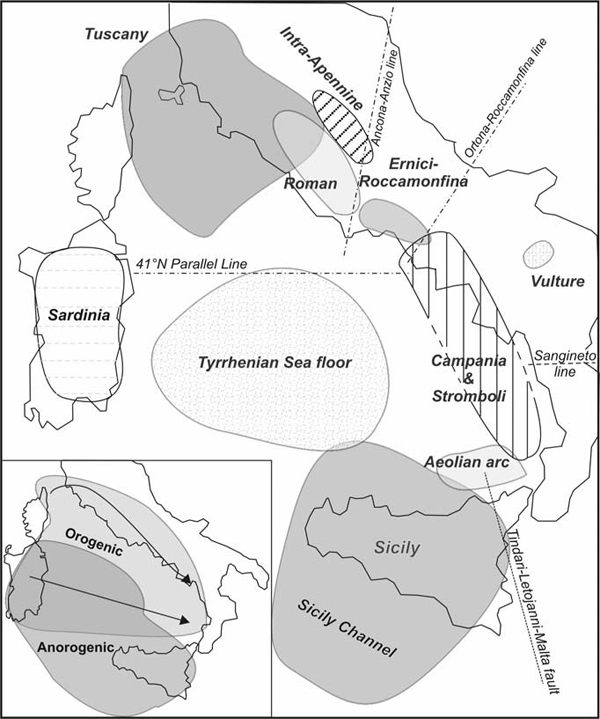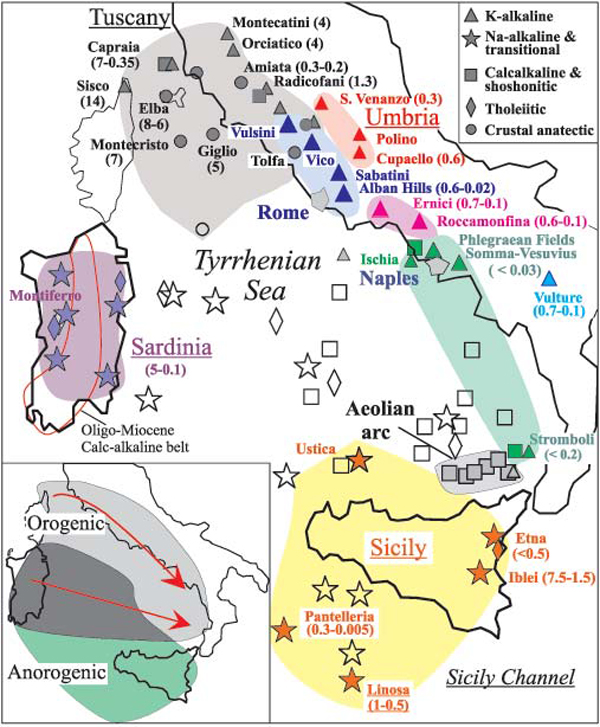Italian Magmatic Provinces
The Tyrrhenian Sea region is one of the most complex geodynamic settings on Earth. Its complexity is clearly expressed by the large variety of Plio-Quaternary volcanic rocks erupted in the area. These range from subalkaline (tholeiitic and calc-alkaline) to Na- or K-alkaline and ultra-alkaline, from mafic to silicic, and from oversaturated to strongly undersaturated in silica. Trace element contents and isotopic ratios are also variable, covering mantle and crustal values, and ranging from typical intra-plate to orogenic compositions.Plio-Quaternary magmatism in Italy exhibits an extremely variable composition, which spans almost entirely the spectrum of magmatic rocks occurring worldwide. Petrological and geochemical data provide a basis for distinguishing various magmatic provinces, which show different major element and/or trace element and/or isotopic compositions. The Tuscany province (14–0.2 Ma) consists of silicic magmas generated through crustal anatexis, and of mantle derived calcalkaline to ultrapotassic mafic rocks. The Roman, Umbria, Ernici-Roccamonfina and Neapolitan provinces (0.8 Ma to present) are formed by mantle derived potassic to ultrapotassic rocks having variable trace element and isotopic compositions. The Aeolian arc (?1 Ma to present) mainly consists of calcalcaline to shoshonitic rocks. The Sicily province contains young to active centers (notably Etna) with a tholeiitic to Na-alkaline affinity. Finally, volcanoes of variable composition occur in Sardinia and, as seamounts, on the Tyrrhenian Sea floor. Magmas in the Aeolian arc and along the Italian peninsula have a subduction related geochemical character, whereas the Sicily and Sardinia provinces display intraplate signatures. Intraplate and orogenic volcanics coexist on the Tyrrhenian Sea floor.
The geochemical and isotopic complexities of Plio-Quaternary magmatism reveal that the upper mantle beneath Italy consists of various domains, spanning both orogenic and anorogenic compositions. Isotopic data suggest that compositional heterogeneity originated from mixing between various mantle reservoirs, and between these and subduction-related crustal material. This probably occurred during the Cenozoic-Quaternary geodynamic evolution of the western Mediterranean. A "magmatic province" is defined as a relatively restricted zone within which igneous rocks have been emplaced over a relatively short period of time, of a few Ma or less.
The rocks of each province show peculiar compositional characteristics, such as petrochemical affinity, geochemical signatures, or even a particular association of magma types, which make them different from rock associations occurring in other zones. However, rocks of a given province are not strictly comagmatic, i.e. do not necessarily derive from a single source or magma type, although in some cases they do. The underlying assumption of this definition is that magmas closely associated in space and time and showing specific compositional characteristics, are likely related to common geological events, which are somewhat different from those occurred in other areas. Based on the present definition, the Plio-Quaternary igneous activity in Italy has been grouped into the following magmatic provinces (Peccerillo 2002):

Magmatic provinces in Italy, as identified from major, trace element and isotopic characteristics of mafic rocks. The Ancona-Anzio, Ortona-Roccamonfina, 41° Parallel, Tindari-Letojanni-Malta and the Sangineto tectonic lines are also indicated. From Peccerillo (2005).

Distribution, petrochemical affinity and ages of the main Plio-Quaternary magmatic centres in Italy. Open symbols refer to outcrops below the sea level. From Peccerillo (2005).
The Tuscany Province
Both mafic and silicic rocks occur in this province. Silicic rocks are either of crustal anatectic origin or, in most cases, represent mixtures between crustal magmas and various amounts and types of mantle-derived melts. Mafic rocks range from calc-alkaline and shoshonitic to potassic and ultrapotassic.The Intra-Apennine Province
This province comprises a number of small ultrapotassic monogenetic centres (e.g. San Venanzo and Cupaello) scattered through the internal zones of Apennines. The best known volcanic rocks consist of ultrapotassic kalsilite-pyroxene and olivine melilitites (kamafugites). Incompatible element ratios and isotopic signatures are similar to the Roman Province. However, the petrological characteristics are different, with the intra-Apennine kamafugites displaying lower Al2O3 and Na2O, and higher CaO, K2O/Na2O and degree of silica undersaturation. Intra-Apennine volcanic also include some carbonate-rich pyroclastic rocks, which have been suggested represent carbonatitic magmas.The Roman Province or Latium Province
This is part of the belt of potassic and ultrapotassic rocks running from northern Latium to the Neapolitan area, which was defined as the Roman Comagmatic Region by Washington (1906). The Roman Province (or Latium Province) includes Vulsini, Vico, Sabatini and Colli Albani volcanoes. Potassic rocks (KS) basically consist of trachybasalts, latites and trachytes; ultrapotassic rocks (HKS) are represented by leucite-tephrites, leucitites to leucite-phonolites.Evolved rocks largely prevail over mafic ones, and mainly occur as large ignimbritic sheets and fallout deposits. Isotope compositions are still close to crustal values, but are less extreme than in Tuscany. Incompatible element ratios define distinct trends than those observed for mafic potassic and ultrapotassic rocks of Tuscany.
The Ernici-Roccamonfina Province
This province is characterised by the close association of KS and HKS rocks, showing diverse geochemical and isotopic signatures. Some low potassium mafic rocks falling in the calc-alkaline compositional field have been also found. Potassic rocks display ratios of some incompatible trace elements such as Ba/La, and radiogenic isotope signatures that are close to those of the eapolitan volcanoes (Vesuvio, Campi Flegrei, Ischia). On the contrary, ultrapotassic rocks resemble the Colle Albani and other Roman volcanoes. Therefore, the Ernici-Roccamonfina zone is characterised by the coexistence of Roman-type and Campanian-type rocks.The Campania Province
Somma-Vesuvio, Campi Flegrei and Ischia are the largest and best known volcanoes in this province. The composition of volcanic rocks is variable, from potassic to ultrapotassic; calc-alkaline rocks are also found by borehole drillings and among lithic ejecta. The mafic rocks with different enrichment in potassium have comparable concentrations for several incompatible elements and exhibit less extreme isotopic compositions than the equivalent rocks of the Roman Province.Overall, trace element ratios and isotopes basically coincide with the rocks from Stromboli in the eastern Aeolian arc, a volcano consisting of calcalkaline, shoshonitic and potassic rocks. This has led to the conclusion that Vesuvio and adjoining volcanoes do not represent the southern end of the Roman Province but rather the northern extension of the eastern Aeolian arc (Peccerillo 2001). The Pontine Islands are here considered as part of the Campania Province, although they contain, in addition to Quaternary potassic volcanics, older rocks (about 4 Ma-old rhyolites at Ponza) which are calc-alkaline in composition and probably related to a Pliocene volcanic arc along the tyrrhenian Sea floor.
Mount Vulture
This volcano is located east of the southern Apennines and is composed of alkaline rocks that are enriched in both Na2O and K2O (De Fino et al. 1986). Haüyne is common in these rocks. Vulture is petrologically and geochemically different from any other Italian volcano. Such a diversity was early recognised by Washington (1906) who established a separate magmatic province for this volcano (Apulian Region). The latest activity at Vulture is characterised by explosive eruptions emitting carbonate-rich material (Stoppa and Woolley 1997).The Aeolian arc Province
This is divided into a western, a central and an eastern sector. The western Aeolian arc (Alicudi, Filicudi, Salina) consists of calc-alkaline rocks with typical island arc signatures. Mafic and intermediate rocks dominate the volcanic sequence, with minor silicic volcanics. The central islands (Vulcano and Lipari) are dominated by calc-alkaline to shoshonitic mafic to silicic rocks; mafic rocks from this sector show isotopic compositions and incompatible trace element ratios similar to the western islands. The eastern arc (Panarea and Stromboli) consists of calc-alkaline to potassic alkaline rocks. Stromboli shows geochemical and isotopic signatures akin to the Neapolitan volcanoes. The Island of Panarea, located between Stromboli and Lipari, has intermediate characteristics between these two volcanoes.The Sicily Province
This includes several recent to active volcanoes (Etna, Iblei, Ustica, Linosa, Pantelleria and some seamounts) with an intraplate tholeiitic to Na-alkaline affinity. Rock types range from mafic to intermediate, but peralkaline rhyolites (pantellerites) are abundant at Pantelleria. All these volcanoes display intraplate geochemical signatures, although Etna and Ustica show some element abundances close to arc rocks.The Sardinia Province
This province consists of central volcanoes, basaltic plateaux and monogenetic centres composed of tholeiitic to Na-alkaline rocks (basalt to rhyolite, basanite and trachybasalt to phonolite and trachyte). It overlies calcalcaline rocks of Oligo-Miocene age.The Tyrrhenian Sea floor
Several volcanoes with calc-alkaline, tholeiitic (MORB and arc tholeiites) to Na-transitional and alkaline affinity coexist on the Tyrrhenian Sea floor. According to some authors (Savelli 1988; Locardi 1993), the calc-alkaline and shoshonitic seamounts developed along arcuate structures that become younger from west to south-east. The older volcanic cycle (4.5 Ma) of Ponza Island may represent the northern end of one of these arcs.The magmatic provinces described above are often separated from each other by tectonic lines of lithospheric importance, such as the the Tindari-Letojanni-Malta Escarpment fault, dividing western and eastern Aeolian arc, and the Ancona-Anzio line, separating the Roman and the Ernici-Roccamonfina provinces.
Bibliography
• Peccerillo. A. Plio-Quaternary Volcanism in Italy. (2005)


